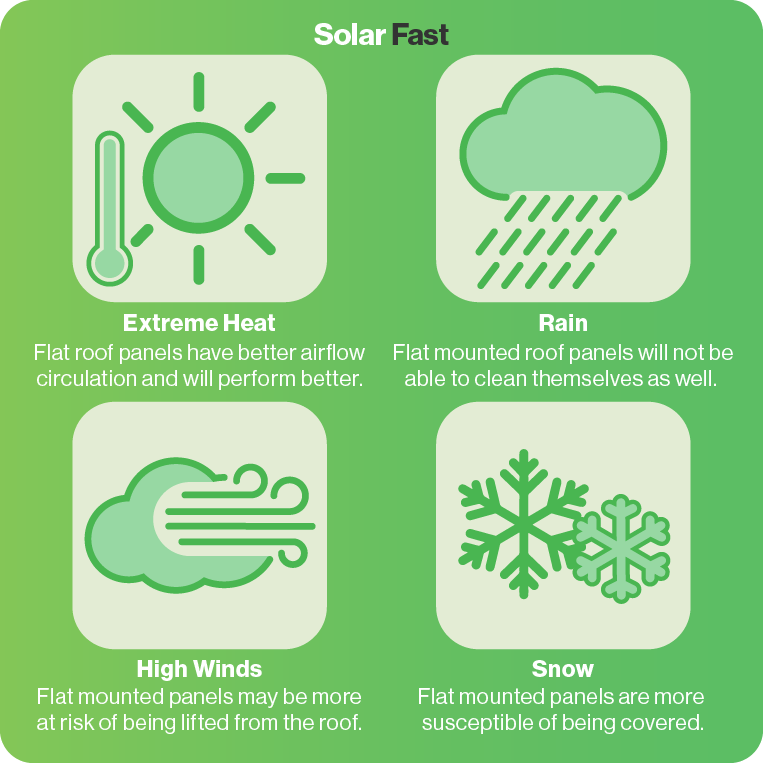Installing on flat roofs is a viable option, whether the installation is for a residential or commercial solar system.
Most domestic installations will be on a sloping or pitched roof as that is the ‘norm’ in UK housing. However, we still have a whole lot of flat roofs on people’s property – including extensions, garages and garden rooms.
Why would you install solar on a flat roof?
The first answer to this question would usually be ‘because I don’t have a pitched roof’ but that’s not the only reason.
Some homes may only have a North facing roof, so flat panels on an out building, or the garden, would be the best way to hoover up the sunlight.
If the main roof on your home is sometimes shaded, or even partially shaded, it may be advisable to fit some panels on a flat surface along with the ones on top of the house.
You may even live in a flat! This could be slightly more complicated if you share the building with others, or you are renting, but placing panels on the top of tower blocks and flats is a great idea.
So, how do you install solar panels on a flat roof?
There are many systems that can be used to attach solar panels to flat roofs.
Let’s take a look at a few:
Mini Rails
Mini rail systems are popular when fitting on box section metal roofs.
These rails are screwed straight into the roof using self-tapping screws and, generally, hold one or two solar panels.
For arrays with more panels the rails are connected using a mid-fixing section.
The advantages of mini rails are they are cheap, easy to fit and perfect for roofs with low load bearing.
They do tend to place the panels at a shallower angle than A frames and, sometimes, the panels can actually be flat.
When panels are flat, they don’t self-clean in the rain, so extra cost may be incurred for keeping the array spotless.
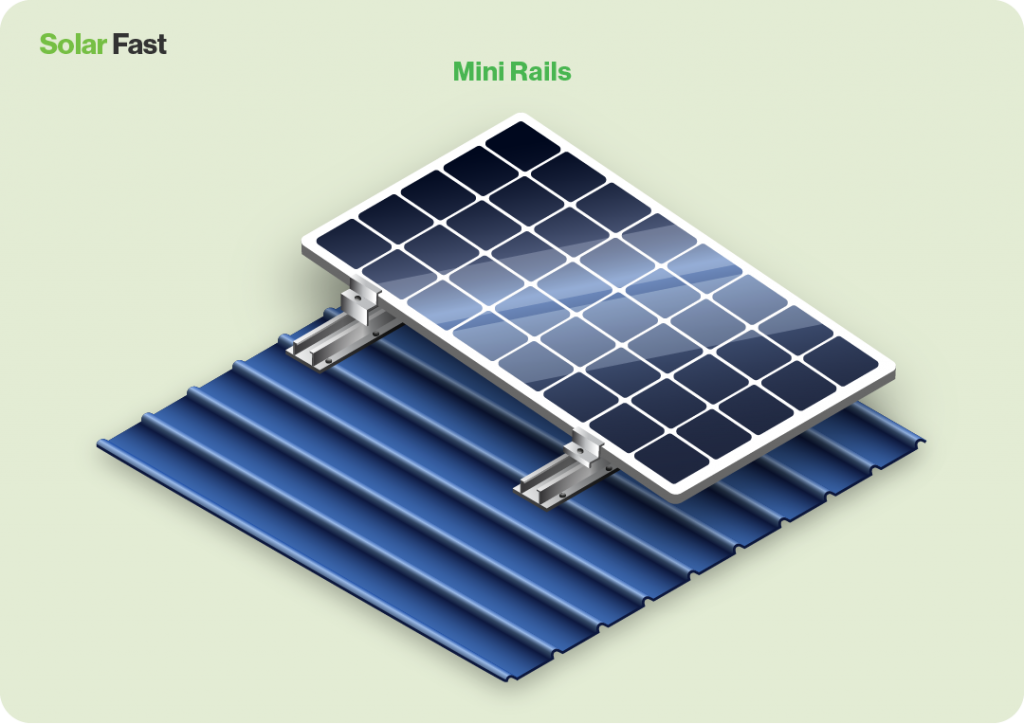
A Frames
A Frames are by far the most popular way of fitting panels on flat roofs or flat ground.
They can be bolted to roofs, held down using ‘ballast’ or tethered to ground anchors … and they allow the panels to be set at the perfect angle.
While they are often more expensive than mini rails, they are also much more adaptable and since they angle the panels, will save money on cleaning.
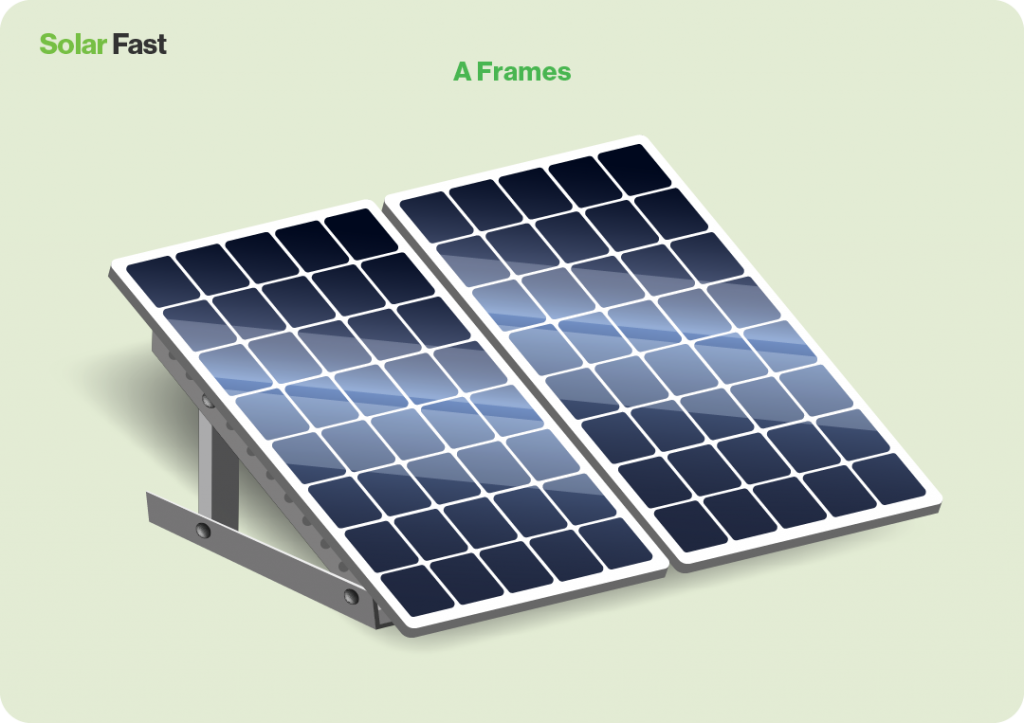
Tubs
Does exactly what it says on the tin… or tub!
If you imagine a domestic storage container cut in half, diagonally, then you’ll be somewhere near the look of a solar panel mounting tub.
Usually, the tub is placed on a flat surface and then filled with sand, or even water, to secure it.
The panels are then secured to the tub at the correct angle, which will be the angle the tubs are made/cut.
Tubs are not just for flat roof systems; they can be used for floor mounting too – especially on solar farms.
They are easy to manoeuvre, lightweight and, as they are much simpler to get between, cleaning the panels is a doddle too.
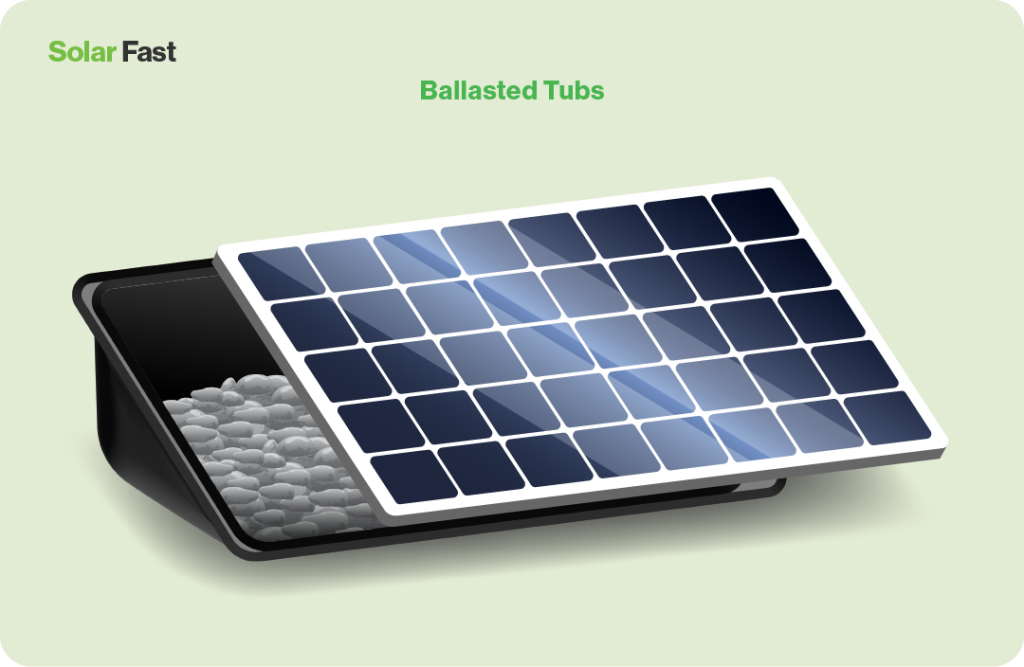
Learn more about mounting rail systems for solar panels.
Angled Systems for East and West facing Panels
One great advantage of a flat roof is you can lay the panels at any angle you like – and in any direction.
You could point them in a southward direction to get the most from that kind of set up, or you can go for an east/west array that can utilise many more panels – as there is no shading – to increase your yield.
German manufacturer Renusol claim that east/west systems can yield up to 30% more power than south facing systems.
Plus, because the panels support each other they are less susceptible to air pressure and, therefore, can be more secure.
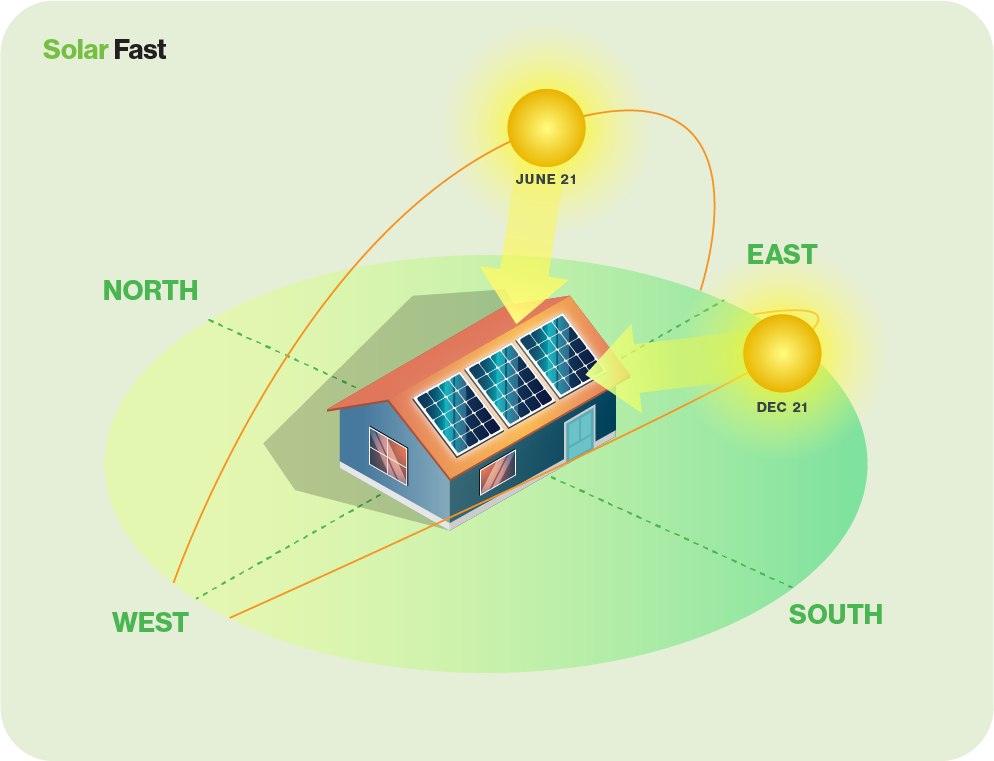
Best angle for solar panels on flat roofs
As we say, the fact you get to choose the angle your panels sit on a flat roof is a huge advantage.
The optimum angle for a solar panel is between 30 and 40 degrees.
Roofs in the UK can be pitched between 20 and 50 degrees, with most falling between 40 and 50.
So, most roofs in the UK are perfect for solar panels but, if your home is in the lower or higher percentile your panels are going to be less efficient.
Benefits of flat roof solar panels
There are a fair few benefits from installing solar panels on a flat roof but one of them remains constant no matter what your choice of mounting system is – free power direct from the sun!
However, there are a few cool things that are exclusive to flat roof mounting.
You won’t be limited to the types of solar panels you use as you usually have more room, much more scope to use 2-way arrays and no shading.
You can use less efficient panels, which are usually cheaper, to generate your electricity because you can fit more in a smaller space.
The best angle for a panel can depend on where it is, which part of the world you are in and what kind of panel it is.
Flat roofs do not dictate an angle so you can set your panels up to the perfect pitch for that particular building – this helps with that self-cleaning too.
Another benefit from fixing panels on a flat roof is they are less visible from the ground – though we think panels look cool anyway!
What are the benefits of installing solar on a flat roof?
Your home will benefit from green, clean, renewable energy.
There is more flexibility with the pitch of the panel. As a result, your installer can ensure that your panel sits at an angle to capture the optimum number of solar rays, whilst remaining self-cleaning in the rain.
You can choose from a number of different types of Solar Panels.
Installing Solar PV Panels onto a Flat Roof is usually more discrete and barely visible from the ground.
Flat roofs provide easy access and plenty of room for installation and maintenance.
Disadvantages of installing solar on a flat roof?
Flat roofs are designed differently from pitched roofs and are not always the best for load bearing.
The weight of the panels, and the mounting system, need to be worked out perfectly to ensure the weakest parts of the roof will not be affected.
Panels on a pitched roof can butt up to each other, leaving no gaps, whereas panels on a flat roof need to be spaced so they don’t shade each other. This means flat roof systems take up much more space.
How much does a flat roof solar system cost?
How long is a piece of string?
A little bit cheaper than a pitched roof-based piece of sting is the answer!
The average cost of rails and installation for a pitch roof, in the UK, is around £1,2500 per kW … the same size systems, using a flat roof would be between £750 to £900 per kW.
One of the reasons for this is the labour costs.
Installing on a flat roof requires less safety equipment, less complicated frames and fewer people.
Do you need planning permission for solar on a flat roof?
No, you generally won’t need to get planning permission to install panels on a flat roof – so long as you comply with all the building regulations already in place.
The panels themselves need to be at least a meter from the edge of the roof, for wind loading reasons, and must not stick up over a metre from the surface of the roof.
However, if you move off the roof onto the floor you will need to apply for permission for anything that covers an area over 9 metre square.
We worked out that would be 6 of our panels, so you could only really use the floor for half a domestic install, or for additional capacity.
Commercial installation on factories etc wouldn’t usually need any planning permission.
However, if you live in a listed building, an Area of Outstanding Natural Beauty or in a home/area subject to any conservation protection, you will need to seek advice on planning.
How does the weather affect solar panels on flat roofs?
This very much depends on the method of fitting, the location of the panels and the weather.
Extreme Heat
In this instance the flat roof panels will be at an advantage.
Generally fitted with a great deal of space around them, panels on flat roofs will be slightly cooler than panels mounted close to the roof as they are on a traditional pitched roof system.
As a panel heats up, the resistance in the solar cells increases too – this means the electricity finds it harder to ‘flow’ and the yield of the panel will drop.
On a flat roof system, with angled panels, natural airflow circulates around the panels and reduces the temperature.
High Winds
The winds in the UK, while cold and annoying, are not usually strong enough to bother a solar array on anyone’s roof.
However, as climate change increases extreme weather events start to get more common, and we may start to see more ‘hurricane’ levels of wind.
In these circumstances, the flat roof solar system may be more at risk than its pitched roof counterparts due to the wind being able to get under the panels and lift them from the roof.
Ballasted systems would be the ones most likely to fail in these circumstances, whereas those bolted to roofs would stand up against much more robust winds.
Rain
Again, the chances of getting rain that will harm any system in the UK are unlikely.
The only disadvantage a flat roof system may have, depending on the angles the panels are mounted at, would be the inability to naturally clean itself.
Pitched roof solar systems rely on the rain to keep the panels clear of dust, dirt and grime but, the flatter the angle the panels are mounted, the less likely the rain will run off them taking the dirt with it.
Snow
Again, the flatter the angle the more likely the build-up of snow.
So, snow does not present much of a danger to a flat roof solar system, but these systems are more susceptible to getting covered in snow which will prevent the light from getting to the cells – has to be about 5cm to totally stop any production though.
